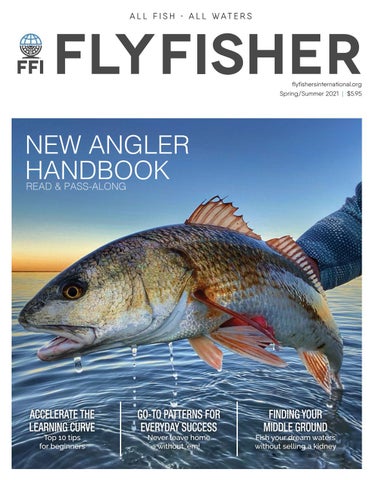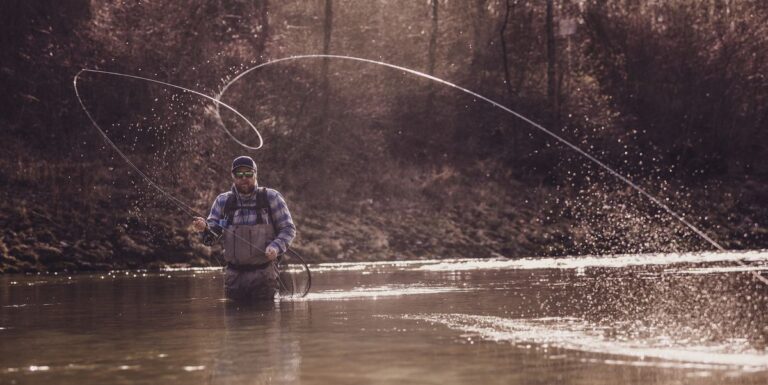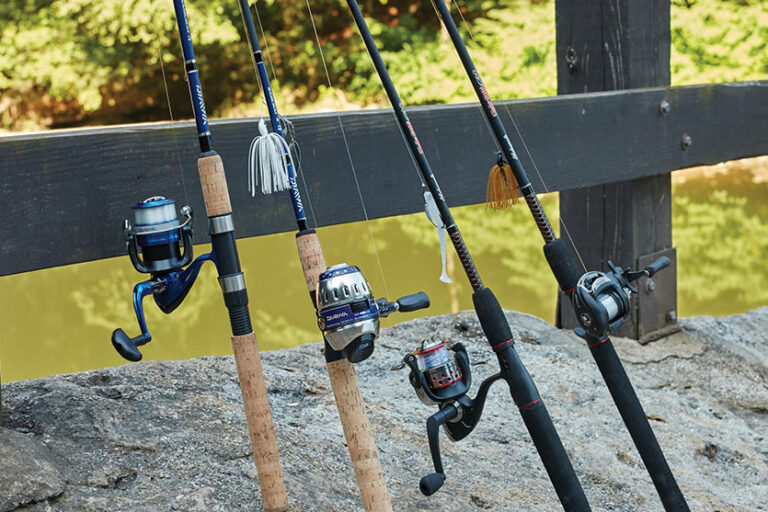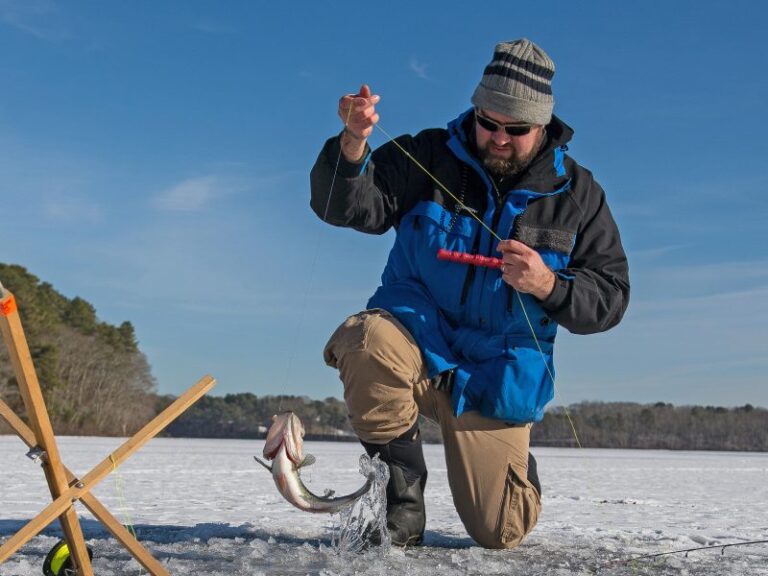Locating fish in a pond requires knowledge of their habits and behavior. In order to find fish, it is important to understand their natural habitats and preferred food sources.
When trying to locate fish in a pond, it is important to consider factors such as water temperature, time of day, and available food sources. Additionally, understanding the structure and depth of the pond can help identify potential hiding spots for fish.
Observing the behavior of birds and other wildlife can also provide clues as to where fish may be located. By using this knowledge, anglers can increase their chances of catching fish and have a successful day on the water. With these tips and tricks, anyone can improve their ability to locate fish in a pond and enjoy the thrill of the catch.

Credit: empressofdirt.net
Why Knowing The Habits Of Fish Is Important In Catching Them
Locating fish in a pond: why knowing the habits of fish is important in catching them
Fishing in a pond can be a rewarding activity, but only if you know where to find the fish. Many anglers make the mistake of casting their line haphazardly, hoping to get lucky. However, if you take the time to understand fish behavior, you’ll have a higher chance of catching fish.
We’ll explore the significance of understanding fish behavior and the factors that affect it.
Introduction To The Significance Of Understanding Fish Behavior
Fish are living creatures, and like all animals, they have a set of behaviors that they follow. Understanding their habits can make it easier to locate and catch them. This knowledge can be valuable to fishers who are looking for a fun and fulfilling experience.
Factors That Affect Fish Behavior
Several factors influence how fish behave. Here are some of the most significant factors:
- Water temperature: Fish, like most cold-blooded creatures, are affected by their environment’s temperature. As such, the temperature of the water can significantly impact their behavior. For example, higher temperatures can increase fish activity, while lower temperatures can decrease it.
- Light: Light plays an essential role in fish behavior, as it affects how they navigate and communicate. Different fish species have varying light requirements and behaviors in response to it. For instance, some fish species prefer dimly lit environments, while others thrive in bright areas.
- Food availability: Like all creatures, fish need food to survive. Therefore, the availability of food can have a significant impact on their behavior. If food is scarce, fish may be more aggressive in their pursuit of it. However, if food is abundant, they may become less active.
- Water clarity: The clarity of water can also influence how fish behave. Clear water allows them to see predators and prey better, making them cautious and fearful. Meanwhile, murky water can make fish bolder, as they have a harder time spotting danger.
Understanding the behavior of fish is crucial for any angler who wants to have a successful fishing trip. By recognizing the factors that impact fish behavior such as water temperature, light, food availability, and water clarity, you can tailor your fishing approach to the specific conditions of the pond.
Identifying The Fish Species In The Pond
Overview Of Various Fish Species In A Typical Pond
A pond can be home to various types of fish species, some familiar and some lesser-known. To identify the fish in a pond, it is essential to have knowledge of key characteristics. Here are some of the most commonly found species in a typical pond:
- Bluegill: One of the most common species in ponds, identified by their olive-green color with blue or purple hues on the lower jaw.
- Largemouth bass: Another familiar species in ponds, distinguishable by their dark green color, with a dark stripe running down their side and a large mouth.
- Catfish: Identified by their broad, flat head, whiskers, and scaleless skin.
- Crappie: A relatively smaller species with silvery-green scales and a distinct pattern of black spots on their back.
- Sunfish: Often mistaken for bluegill due to their similar appearance, it has a smaller mouth and longer pectoral fins.
- Carp: A non-native species, identified by their large scales and a smooth body with barbels on each side of their mouth.
Highlighting The Unique Characteristics Of Each Fish Species Found In A Pond
Bluegill
- One of the most prolific and easy-to-catch fish species in ponds.
- Consume insects, small fishes, and zooplankton.
- Named after the blue coloration on their operculum or gill cover.
- Produce nests on the bottom of the pond with small depressions, where they lay their eggs.
Largemouth Bass
- The ultimate predator found in ponds, known for their aggressive attacks on prey.
- Consume smaller fishes, frogs, insects, and crustaceans.
- Have a lifespan of around 10 years.
- Often create and defend nests for their eggs on the pond bottom through the spring and summer mating seasons.
Catfish
- Known scavengers that consume small fish, insects, and plant materials.
- Have barbels that provide a sensory function, allowing them to detect food even in low visibility conditions.
- Often bottom-dwellers and have a lifespan of around 15 years.
- Can grow up to 1 meter and have been known to weigh over 100 pounds.
Crappie
- Timid and often found in schools in depths of around 10-15 feet.
- Consume smaller fish, insects, and crustaceans.
- Spawn in shallow water in the early spring season.
- Have a lifespan of around 5-7 years.
Sunfish
- Often found in shallow areas of the pond.
- Feed on insects, small fishes, and other invertebrates.
- Create nests in the bottom of the pond, similar to bluegill.
- Have a lifespan of around 5-6 years.
Carp
- Non-native species with barbels on each side of their mouth.
- Consume plants, insects, and small fishes.
- Can grow up to 1 meter and weigh up to 50 pounds.
- Most actively feed during the early morning or late evening.
Knowing about the different fish species in a pond is essential for fishing enthusiasts. Identifying their unique characteristics is crucial in determining the best baits and lures to attract them and increase the chances of a successful catch. Remember to keep your fishing license with you and follow the catch and release policy.
Happy fishing!
Proven Techniques For Identifying Fish Hotspots
Locating fish in a pond: proven techniques for identifying fish hotspots
When it comes to fishing in a pond, identifying the right location can be the difference between having a successful catch or not. To help in your quest to catch fish, we have outlined some proven techniques for identifying hotspots in a pond.
These techniques include still-fishing, drift-fishing, and trolling.
Breakdown Various Fishing Techniques Such As Still-Fishing, Drift-Fishing, And Trolling
- Still-fishing: This is a technique of fishing where you stay in one spot without moving the bait. This method is ideal when fishing in a pond with visible underwater structures such as rocks, weeds, or brush. You can set the bait near the structure, and wait for the fish to come to you.
- Drift-fishing: This technique involves allowing the boat to move with the tide or wind while dragging bait behind it. This technique works best when fishing in an open area of the pond, and the bait should be adjusted according to the depth of the water.
- Trolling: This technique involves fishing while the boat is moving, and the bait is slowly pulled through the water. This technique is ideal for covering larger areas of the pond and catching fish that are swimming in the middle or deeper parts of the pond.
Exploration And Description Of The Best Baits And Lures For Different Fish Species
When selecting baits and lures for catching fish in a pond, it is important to consider the type of fish that are present in the pond. Some of the best baits and lures for different fish species in a pond include:
- Worms: Live worms are one of the most versatile baits for catching fish. They work well for catching bluegill, bass, and catfish.
- Minnows: Live minnows work well for catching crappie, bass, and bluegill.
- Artificial lures: These include soft plastics, spinnerbaits, and crankbaits which are effective for catching bass, crappie, and catfish.
- Fly fishing lures: They work well for catching trout and other small fish species.
Highlighting Factors To Consider When Selecting Baits And Lures In Catching Fish In A Pond
When selecting baits and lures for catching fish in a pond, here are some factors to consider:
- Fish species: Different fish species prefer different types of bait, so it’s important to consider what species of fish you are targeting.
- Water temperature: The water temperature can also affect the type of bait used. For example, during hot weather, fish may prefer live baits over artificial lures.
- Time of year: Seasonal changes can also impact what bait and lures work best. For example, in the spring, fish may be more active and prefer brighter colored lures.
- Water clarity: The clarity of the water can also determine what bait or lures to use. In clear water, it’s best to use smaller, more natural-looking baits, while in murky water, larger and brighter lures are more effective.
By taking these factors into consideration and using the right techniques for identifying hotspots in a pond, you can increase your chances of a successful fishing trip. Happy fishing!
The Science Behind Fish Finders
Fish finders are incredibly useful tools for anglers of all experience levels. These devices use sonar technology to locate schools of fish in ponds, lakes, and oceans. By emitting sound waves through the water, fish finders can detect objects and display them on a screen.
Explanation Of Fish-Finder Technology And How It Helps Detect Fish
Fish finders work by sending out a signal, which then bounces back when it hits something under the water. The device measures the amount of time it takes for the signal to return and calculates the distance to the object.
This process, known as sonar, can detect the presence of fish based on the echo returned.
Using scanned images, fish finders display an image of the area below the boat, showing the depth, temperature, and contours of the lake bottom. This information helps anglers identify the ideal location for casting their line and catching fish.
Highlighting The Important Features Of Fish Finders
When looking for a fish finder, there are several important features to consider. Here are a few noteworthy features that will help you make the most of your fishing experience:
- Transducer cone angle: This determines the coverage of the sonar beam. A wider cone angle can cover more water, while a narrower cone angle provides more detail.
- Chirp technology: Instead of using a single frequency, chirp produces a range of frequencies. This results in more detailed and accurate images of the water column and fish.
- Gps connectivity: Allows anglers to mark and return to successful fishing sites.
- Screen size and resolution: Choose a screen that is large enough and with high resolution for clear image display.
Tips And Tricks To Maximize The Use Of Fish Finders
Having a fish finder is one thing, but knowing how to use it is another. Here are some tips and tricks to maximize the use of your fish finder:
- Position your transducer correctly: The transducer should be located in a place where it can read the water column and have no interference.
- Set the sensitivity right: Adjust the sensitivity of your device to match water depth and clarity.
- Identify fish arches: Fish arches are curved lines on the screen, indicating the presence of a fish.
- Use fish finder pre-set modes: Many fish finders come with pre-set modes tailor-made for different fishing scenarios.
- Practice interpreting the images: It may take a while for you to accurately interpret the images on the screen and identify schools of fish. Keep on practicing and comparing results with actual catches.
By following these tips and tricks and understanding the science behind how fish finders work, you can enhance your fishing experience and catch more fish.
How To Choose The Best Fishing Equipment
Latest Fishing Technologies And Equipment
Fishing gear has come a long way since the days of bamboo poles and hand lines. Today, anglers have access to a wide range of new technologies and equipment that can improve their chances of catching fish in a pond.
Here are some of the latest tools and technologies you should consider adding to your fishing arsenal:
- Fish finders: These devices use sonar to locate fish and give you an idea of the depth and structure of the water below you.
- Gps systems: Gps devices can help you navigate to the best spots in the pond and mark your favorite spots for future trips.
- Portable live wells: Keeping fish alive and healthy until you release them is essential for ethical fishing. A portable live well can help you keep your catch alive and healthy.
- Fishing drones: Drones equipped with cameras can fly over a pond and help you locate groups of fish.
Best Fishing Rods, Reels, And Lines For Catching Fish In A Pond
When it comes to choosing the best fishing equipment for catching fish in a pond, there are several important factors to consider. Here are some of the key things to keep in mind when selecting your gear:
- Rod length and action: Shorter rods are better for fishing in confined areas, while longer rods are better for casting farther. The rod action refers to how flexible the rod is and can affect how easily you can set the hook on a fish.
- Reel type: Spinning reels are a popular choice for pond fishing, as they are easy to use and offer good casting distance and accuracy.
- Line strength and material: The strength of your fishing line should be matched to the size of the fish you are targeting. Monofilament line is a popular choice for pond fishing but may not be as strong as other materials.
Factors To Consider When Selecting The Best Fishing Gear
Selecting the best fishing equipment is not just about choosing the most expensive gear. You need to consider several factors to ensure you have the right set-up for the type of fishing you plan to do. Here are some essential things to keep in mind:
- Type of fish: The species of fish you are targeting will determine the kind of equipment you need. For example, if you’re fishing for larger species, you’ll need a stronger rod and reel.
- Weather and water conditions: The weather and water conditions will affect the type of gear you need. For example, you may need a longer rod to cast farther in windy conditions.
- Skill level and budget: Your skill level and budget should also influence your gear choices. If you’re a beginner, you may want to start with a simpler set-up and work up to more advanced equipment as you gain experience.
Utilizing Drones To Locate Fish
Understanding The Technology Behind Drones And How They Help Locate Fish
Drones are becoming increasingly popular in the field of fishing. They have the ability to hover over bodies of water, allowing anglers to gain a bird’s eye view of the area, and determine where fish are located. When it comes to fishing, drones are incredibly useful tools that help anglers identify the best spots to fish.
The technology behind these unmanned aerial vehicles has come a long way in recent years and is paving the way for greater fishing success.
Highlighting The Benefits Of Using Drones
Anglers who use drones in their fishing expeditions benefit from a range of advantages. Here are some notable benefits of using drones in fishing:
- Drones offer a great way to survey large bodies of water and identify potential fishing hotspots.
- They are able to cover more ground quickly than any other method of surveying, allowing anglers to find fish faster and with less effort.
- Drones offer a unique viewpoint that is difficult to replicate with other fishing tools, giving anglers a high level of detail and allowing them to see fish that would be otherwise difficult to spot.
- Anglers can use drones to spot schools of fish, which can lead to a more successful fishing trip.
Tips And Tricks To Maximize The Use Of Drone Technology In Fishing
If you’re an angler who is interested in using drones to locate fish, keep in mind these tips and tricks that will maximize your chances of a successful fishing trip:
- Practice first: Before using a drone in your fishing expedition, it’s important to practice first. Familiarize yourself with the technology behind the drone and how to operate it effectively.
- Pre-survey: It’s essential to survey the area, map out potential fishing hotspots and mark them on your drone’s gps to save time and avoid unnecessary flying time.
- Battery duration: Most drones offer a maximum flight duration of 30 minutes. So, it’s important to keep an eye on the battery life and to bring multiple batteries on longer outings.
- Weather forecasting: Be aware of the weather conditions beforehand, as strong gusts of wind can push your drone off course or even destroy it.
- Utilize first person view (fpv) goggles: Fpv goggles allow for a more immersive and engaging experience that offers a high level of detail and control.
- Privacy: Make sure to respect other anglers’ privacy, avoid violating local regulations or flying your drone over private property, and respect wildlife.
Using drones to locate fish is an innovative and efficient way for anglers to find fish and increase their chances of a successful fishing trip. As drone technology continues to improve, we can expect to see even more impressive advancements in this field.
Introduction To Proper Planning Techniques
Understanding The Importance Of Proper Planning Before A Fishing Trip
Fishing is a great way to relax, be outdoors and enjoy nature. However, it just won’t be a good fishing experience if you have not planned it properly. Before you go out on your next fishing trip, take some time to plan ahead.
This will help you increase your chances of catching fish and having more fun while you are at it.
Highlighting Factors To Consider When Preparing For A Fishing Trip
Planning a fishing trip involves more than just packing your fishing gear and hitting the water. Here are some factors to consider when preparing for a fishing trip:
- Research the pond or lake: It is important to gather information about the fish species, their behaviour, and their feeding habits in the pond or lake you plan to fish. This information will help you determine the right bait, lures and fishing techniques to use.
- Check the weather: Weather plays a significant role in fishing. Wind, temperature, humidity and barometric pressure all affect fish behaviour. A change of weather can trigger fish to move to different areas in the pond, or to change their feeding patterns.
- Bring essential gear: Be sure to bring everything you need to fish, including your fishing rods, reels, bait, lures and other fishing equipment. Having the right gear can make a huge difference when it comes to catching fish.
- Dress appropriately: Dress according to the weather conditions. Wear clothes that are comfortable, warm and waterproof. This will enable you to remain comfortable during the trip, and focus on catching fish.
- Have a backup plan: Sometimes, things don’t always go according to plan. If you plan to fish in a certain area, but the water quality is poor or overcrowded, have a backup plan to avoid disappointment.
- Be prepared for emergencies: Always be prepared for emergencies by carrying essential first-aid, and a charged mobile phone. It is also important to let someone know where you will be fishing and when you plan to return.
With proper planning, you will not only increase your chances of catching fish, but you will also have an enjoyable fishing experience. Happy fishing!
Picking The Right Time To Fish
Understanding The Impact Of Changing Weather Patterns And Other Factors On Fish Behavior
Fish behavior is influenced by a range of factors such as weather patterns, water temperature, and time of day, which can affect when and where fish are most active. Understanding these factors can help you choose the best time for fishing and increase your chances of success.
- Weather patterns: Changes in weather conditions can impact fish behavior. They are more active during cloudy and overcast days as compared to sunny and hot days. Also, changes in atmospheric pressure can affect migratory patterns, spawning behavior, and even feeding patterns.
- Water temperature: Fish are cold-blooded animals and their body temperature is directly related to the temperature of the water around them. As the water temperature changes, so do the fish’s metabolism and activity level. For example, high water temperatures reduce the oxygen levels in the water, which can make fish inactive.
- Time of day: Some fish species are active during daylight hours, while others are more active at dusk or dawn. Knowing the feeding patterns of the fish species in the pond will help you determine the right time of day to fish.
Techniques For Determining The Right Time To Fish In A Pond
Determining the right time to fish in a pond requires careful observation and consideration of various factors that affect fish behavior.
- Observe the behavior of the fish: Spend some time observing the behavior of the fish in the pond. This will help you understand their feeding patterns and behavior changes during different times of the day, and different weather conditions.
- Use a fish finder: A fish finder can help you determine the exact location of fish in a pond. It uses sonar technology to detect the presence and movement of fish in the water.
- Check the weather forecast: Keep an eye on the weather forecast to see any significant changes in weather patterns. This will help you determine the best time and location for fishing.
- Choose the right bait: Different fish species prefer different types of bait. Research the fish species in the pond and choose the appropriate bait to attract them.
Remember that there is no single best time to fish. Each pond and fish species are unique and require different approaches. By understanding the impact of changing weather patterns and other factors on fish behavior and using the right techniques, you can increase your chances of success in locating fish in a pond.
Conclusion
Locating fish in a pond is an art that requires patience, skill, and a bit of luck. With the right knowledge and tools, you can enhance your chances of catching a variety of fish species. Remember to read the signs, study the pond’s structure, and use the right bait and equipment.
Always consider the time of day and weather conditions, and be respectful of other anglers and their space on the pond. Whether you are a seasoned fisherman or a beginner, fishing in a pond can be a rejuvenating and satisfying experience.
It can serve as an opportunity to connect with nature and enjoy the beauty of the great outdoors. So the next time you decide to go fishing, put these tips into practice and be prepared for a successful and enjoyable outing.
Happy fishing!





